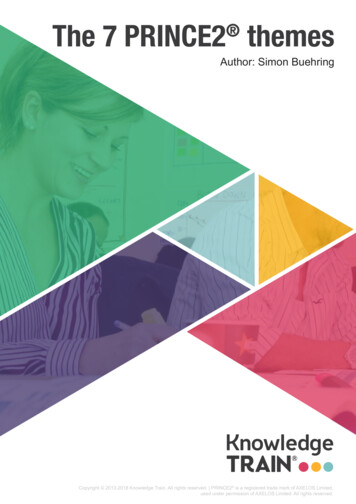
Transcription
The 7 PRINCE2 themes Author: Simon Buehring Copyright 2013-2018 Knowledge Train. All rights reserved. PRINCE2 is a registered trade mark of AXELOS Limited,used under permission of AXELOS Limited. All rights reserved.
IntroductionThis article describes the PRINCE2 themes. It’s the second in a series of three study guides designed tohelp you learn about PRINCE2. The other two - the PRINCE2 Principles and the PRINCE2 Processes - areavailable to download as ebooks. They are all based upon the 2017 version of PRINCE2.BackgroundBefore we get into the themes in detail, it would be helpful to discuss a couple of core concepts first.ProductsPRINCE2 uses the word product to refer to the outputs of projects and project management processes.Often on projects people refer to the word ‘deliverables’ to mean the tangible or intangible outputs of aproject e.g. a new I.T. system. In PRINCE2, deliverables and products mean the same thing.There are, in fact, 2 types of products in PRINCE2: specialist and management [1].Specialist products are those outputs (deliverables) which require special skills to design and to build. Forexample, the new I.T. system requires software architects, web developers, database designers etc.Management products are the outputs of the project management processes and are created by theproject management team. For example, plans, reports, logs and registers are management products.PRINCE2 defines 26 of these to be used for different purposes throughout the project.Customer-supplier environmentPRINCE2 assumes that every project operates within a ‘customer-supplier’ relationship.This means that a project always has a customer (a person, group or organization) which invests moneyand resources in a project. The customer specifies what shall be delivered from the project. It is thecustomer which expects to see a return on its investment in the form of benefits (these maybe be financialor otherwise).The supplier is a person, group or organization which designs, builds and delivers the specialist productswhich have been specified by the customer. These are handed over to the customer after they have beenshown to meet their specified quality criteria. They are then used by the customer to realize benefits.Minimum requirementsPRINCE2 defines several things about how the methodology should be implemented on a project beforeit can be considered a ‘PRINCE2 project’. These are referred to in the PRINCE2 manual as minimum1
requirements. Each of the 7 themes have their own minimum requirements which shall be addressed in thisarticle.What's a theme in PRINCE2?Themes in PRINCE2 are those areas of project management which must be addressed continuouslythroughout the project [2]. Themes are based upon the principles and they are applied throughout the projectby using the processes.We shall know describe each of the 7 themes in PRINCE2.Business caseThe purpose of this theme is to put in place mechanisms which assists the senior decision makers todecide whether the project is (and remains) a worthwhile investment [3]. It is the theme which primarilyimplements the ‘continued business justification’ principle.2
Both the customer and the supplier require a business case for a project. Each business case is writtenfrom the perspective of justifying an organization’s own involvement in the project. In PRINCE2 the focus ison the customer’s business case because this justifies the investment in the project and explains why theproject is needed.ExecutiveA business case is also a management product and is ‘owned’ by the executive. At all times therefore,the executive needs to ensure there is an acceptable business case, otherwise they should instruct theproject manager to close the project. Not wasting any more time and money on a project is much betterthan continuing with a project which is not worthwhile.Outline business caseThe executive is responsible for providing the first (outline) version of the business case although this canalso sometimes be given by corporate/programme management as part of the project brief. This versionthen gets updated with more detail in the initiation stage of the project.Outputs, outcomes and benefitsEvery project will deliver one or more ‘specialist’ products (known as outputs), which will then be usedat the end of the project by people in the customer organization. By using them, this will change (positively)the way in which they do their everyday (business as usual) work. This change is known as an outcome.The measurable improvements which will then result to the customer organization are what are known asbenefits.For example, a company investing in a new business information computer system sets up a project. Theoutput of the project would be the new I.T. system. The outcome might be that the staff are able to do theirwork more efficiently. The benefit might be that the company saves money on staff salaries.Senior userThe senior user role is responsible for both specifying the benefits of the project, and for realizing them i.e.make sure that they actually are achieved after the project closes. This means that the people who performthe senior user role need to come from those areas of the customer organization which are most oftenimpacted by the changes (outcomes).Benefits management approachHow the benefits will be measured, when and by who is documented in a benefits management approach(one of the 26 management products). This gets updated as and when the benefits are realized, whichfor most projects is after the project has closed. This is because at the end of the project, the specialistproducts are handed over to the users and the operational or support teams. They then use the products as3
part of business-as-usual and by doing so, realize the expected benefits (or so we would hope!).Justification does not have to be financialFor most commercial organizations, often the business justification for projects is a financial one i.e. willthere be a return on investment (in terms of money). But PRINCE2 says that the business justification canbe made in other ways too.For example, consider a proposal to equip a residential apartment block with a water sprinkler systemin case of fire. Such a project would have clear benefits (in terms of saving people’s lives in a fire) but itprobably cannot expect a return in investment in purely financial terms. The decision to invest in such aproject would therefore need to consider the wider benefits to society of keeping its citizens safe.Minimum requirementsYour project must create and maintain a business justification (in the form of a business case), and youshould review and update it throughout your project. You must define management actions to ensure theexpected outcomes are achieved and the benefits are realized. You must define and document the rolesand responsibilities for the business case and the management of benefits. Finally, you must produce andmaintain a benefits management approach.OrganizationThe purpose of this theme is to define and set up a project management team structure which defines whois accountable and responsible on the project [4].4
Customer organizationPRINCE2 is based upon a ‘customer/supplier environment’ whereby the customer organizationspecifies the result (the specialist products), and pays for the project, because it deems that the project canrealize sufficient benefits in the future to make the project a worthwhile investment.Supplier organizationThe supplier organization is the person or company who/which will supply the products which have beenspecified by the customer. On a project where all the work is being done in-house, then the customer andsupplier will be part of the same organization.Project board roleThe key decision-making role on the project is known as the project board which consists of 3 other roles:executive and senior user (both from the customer) and the senior supplier (from the supplier). It’simportant to note however that the project board is not a democracy and ultimately, it’s the executive whotakes the decisions, advised and supported by the other 2 roles.5
Executive roleThe executive role can only be performed by one person and must be able to represent the business i.e.that part of the customer organization which is paying for the project). This role is ultimately accountable forthe project.Senior user roleThe senior user role which is responsible for specifying and realizing benefits is also responsible forspecifying the project’s requirements and products.Senior supplier roleThe senior supplier is accountable for the quality of the specialist products which they will deliver to theproject.Project assurance roleReviewing project documentation such as plans and a business case could be quite time-consuming soPRINCE2 recommends that project assurance can be delegated by the project board members to others.The project assurance role is all about assuring the project board independently of the project manager thatthe project is being conducted properly. Project assurance will give advice to the project manager and willreview documents prior to their approval by the project board.Project manager roleThe project manager role is responsible for the day to day management of the project and reports on aregular basis the progress to the project board. This in the form of a highlight report. The project manageris responsible for keeping issues and risks under control, monitoring progress, taking corrective actionwhen there is a slippage from the plan, and escalating exceptions to the project board.Team manager roleTeam managers manage teams of specialists who have the requisite skills to enable them to design andbuild the products which have been specified by the customer. They are responsible for delivering thespecialist products, on time and within the agreed tolerances. They report on a regular basis to the projectmanager.Change authority roleThe change authority role is responsible for taking decisions about requests for change (RFC’s) and offspecifications (more later in the Change theme).6
Project support roleThe project support role assists project and team managers with administration, writing of reports,monitoring of progress and with administering tools.Sharing rolesSome of the above roles can be shared (i.e. more than one person can perform the role). In PRINCE2 allroles can be shared EXCEPT for the executive and project manager roles.Combining rolesSome roles can be combined (i.e. one person can perform multiple roles). However, the project assurancerole can never be shared with the project manager, team manager or project support roles, otherwise theywould not be independent of the project manager.StakeholdersAll of the above roles form the project management team and they are all stakeholders on the project.However, stakeholders are not just the members of the project management team, but they can be anyonewho is affected by the project, be affected by the project or perceive themselves to be affected by it.Communication management approachPRINCE2 recommends that a communication management approach is written which identifies all theproject’s stakeholders, their information needs and the means and frequency of communication e.g. thequality assurance manager requires a copy of the weekly highlight report, written by the project manager.Minimum requirementsYou must define your project’s organization structure and roles (by ensuring all responsibilities inPRINCE2’s role descriptions are fulfilled). You must define your project’s approach to communicating andengaging with stakeholders and you must produce and maintain the project initiation documentation (PID),and a communication management approach.QualityThe purpose of this theme is to define and implement the mechanisms whereby the project can establishwhether the products are ‘fit for purpose’ [5].7
Definition of quaityPRINCE2 defines quality as whether a product is ‘fit for purpose’ i.e. whether it meets its agreed andstated requirements. The project’s approach to the management of quality on the project is documented bythe project manager in a quality management approach.Quality management systemMany organizations have a quality management system (QMS) which is a corporate-wide set of qualitypolicies, procedures and standards expected within the organization.Quality assuranceThe corporate role known as quality assurance (QA) is responsible for defining and maintaining the QMSand for checking that projects remains in compliance. QA often does this by performing a quality auditwhich looks for evidence of compliance on the project.Quality assurance and project assurance are differentThe QA role is therefore external to the project whereas project assurance is a role which is internal tothe project (it’s one of the project management team roles). Project assurance assures the project board8
that the project is being conducted properly whereas QA assures corporate management that the projectcomplies with corporate standards, policies and procedures.Quality controlQA is not to be confused with quality control, which refers to the performing of those quality methodswhich will be used to check if a product is “fit for purpose”, the maintaining of quality and approval records,and the gaining of acceptance.During the quality method, quality records will be maintained e.g. the details of the results of a test andthen, based upon the results, the product shall be judged either fit for purpose or not. If it is fit for purposethen the product can be approved and approval records will be needed. This is often a signature on a formor an email and is an example of an approval record.BaselinesOnce approved the product becomes a baseline. This usually entails giving it a version number and it thenbecomes subject to change control i.e. nobody is allowed to modify it without gaining approval after raisinga request for change (RFC).If the product is not fit for purpose, the supplier needs to perform some further work on the product to bringit up to a standard where it can be quality controlled once more.Quality planningOn a project, the project manager is responsible for quality planning which means defining the qualitycontrol methods and the project’s acceptance criteria (the measurable attributes of the final product i.e. theproduct handed over to users at the end which will make it acceptable to the customer). Acceptance criteriaare derived from the customer’s quality expectations (the high-level business requirements for theproject) and these are agreed before the project begins.Acceptance methodsCertain methods (acceptance methods) will need to be performed to check that the final product meetsthe criteria. If it does, then the project can be closed because it has delivered what it set out to deliver.Acceptance records will record the formal acceptance of the final product by the different stakeholders.Quality registerPRINCE2 defines a quality register where the results of quality methods are recorded. This enables theproject manager to keep control over all the quality control activities which take place on a project.9
Minimum requirementsYou must define and maintain a quality management approach for your project which covers qualitycontrol and project assurance and defines the roles and responsibilities for quality management. You mustspecify explicit quality criteria for products and maintain appropriate quality records. You must summarizethose quality activities in some form of quality register. The customer’s quality expectations and prioritizedacceptance criteria must be specified in a project product description and you must use lessons to informquality planning on the project.PlansThe purpose of this theme is to define how, when, for how much, by whom and where the project willdeliver products [6].Levels of planPRINCE2 recommends 3 levels of plan each level matching the information needs of the 3 levels of theproject management team. These are10
Project plan (used by the project board) containing project levels costs, timescales and controlpoints. An updated version is created at the end of each stage to reflect actual progress andrevised forecasts; Stage plan (used by the project manager) for day-to-day management of the project. There is onefor each management stage; Team plan (used by a team manager) – covers all the work done by a team.Exception plansIt’s important to remember that exception plans are new plans (not updated versions of existing plans)and they can be used to replace stage plans or the project plan. In the latter case, it must be authorized bycorporate management.BudgetsPlans not only specify which products will be delivered in the scope of the plan, but also the timescales andcosts required. PRINCE2 recommends the following are included in the budget for a plan:1. money to fund the activities to create specialist products (and management activities)2. money to fund responses to risks (risk budget)3. money to fund authorised changes to baseline products (change budget)4. cost toleranceProduct-based planningPRINCE2 recommends an approach to creating all levels of plan called product-based planning. A keystep is to define and analyse products. There are 4 steps:1. Writing a project product description - to define what the project must deliver in order to gainacceptance2. Creating a product breakdown structure - to show the products within scope (note: externalproducts are those that already exist or are being created outside the scope of the plan)3. Writing product descriptions - for the major products4. Creating a product flow diagram - to define the sequence in which the products will be developedPlanning stagesThere are several factors to consider when deciding on the number and length of management stages: The planning horizon at any point in time - it may depend upon the nature of the work The delivery steps – it’s beneficial if management stages align with end of delivery steps Alignment with programme activities The level of risk11
Minimum requirementsYou must ensure that plans enable the business case to be realized. You must have at least twomanagement stages. You must produce and maintain a project plan, a stage plan for each managementstage and exception plans when requested. You must use product-based planning when creating allplans. You must define the roles and responsibilities for planning and use lessons to inform all yourplanning. Finally, you must create and maintain a project product description, a product description foreach product, and a product breakdown structure.RiskThe purpose of this theme is to identify, analyze and control uncertainty and thereby improve the chancesof a successful project [7].DefinitionIn PRINCE2, a risk is defined as an uncertain event, which (if it occurs) will have an effect (either negative orpositive) on the project’s objectives. A risk should NOT be confused with a project issue, which is an eventwhich has happened but wasn’t planned. However, if and when a risk does actually occur then it becomesa project issue.12
Risks can be either: threats (which have a negative impact), or opportunities (which have a positive impact).Risk appetiteEvery organization has its own unique attitude towards risk taking. This is known as risk appetite.Risk budgetEach plan in PRINCE2 will have a risk budget, which is money to be used to fund any risk responses.Risk toleranceRisk tolerance refers to the threshold level of risk, which once exceeded (or forecast to be exceeded) willresult in an exception report being triggered i.e. an exception has occurred.Product-based planning.Risk management procedureInformation about all project risks are maintained in a risk register, and a risk management approach iswritten to outline the general approach to risk management during the project. Included in this approach isa description of the risk management procedure containing 5 steps:1. Identify - threats and opportunities are identified and described in terms of the cause (source ofthe risk), event (area of uncertainty), and effect (it’s impact).2. AssessAssess Estimatethe probability(likelihood),impact,proximityto occur),occur),andand Estimatethe ititisis likelylikely to Evaluatethe overallnet effectall risksEvaluatethe overallnet effectof allofrisks.3. Plan - one or more specific risk responses.4. Implement - the chosen risk responses and assign: riskA riskownerthe individualresponsiblefor managingthe risk Aowner– the– individualresponsiblefor managingthe risk riskTherisk actionee/s– theresponsiblepeople(s) assignedto carryAowner– the individualfor managingtheoutriskthe risk response(s).5. Communicate – report the status of risks to stakeholders using the various PRINCE2 reports.Risk responsesPRINCE2 defines 6 responses to threats: avoid, reduce, accept, transfer, share, and preparecontingent plans, and 6 responses to opportunities: exploit, enhance, reject, transfer, share, andprepare contingent plans.Primary and residual risksAfter performing these responses to primary risks, there is usually some level of risk left over. This isknown as residual risk. Any risks caused by performing risk responses are known as secondary risks.13
Minimum requirementsYou must define a risk management approach covering the risk management procedure to be used, andthe roles and responsibilities for risk management. You must maintain some form of risk register to recordand manage risks and must ensure that risks are identified, assessed, managed and reviewed throughoutthe project. You must use lessons to inform risk identification and management.ChangeThe purpose is to identify, analyze and control any potential and approved changes to baseline products(i.e. products that have been approved) [7].BaselineA baseline refers to a product which has undergone its quality controls, has been deemed ‘fit for purpose’and has been approved by those with authority. At this point the product is usually given a version numbere.g. version 1.0).14
Project issuesA project issue is an event which has happened, wasn’t planned and requires management action. Thereare 3 types: Requests for change (RFC) - request to change a baseline. Off-specifications - this requirement/product hasn’t/cannot be delivered. Problems/concerns – anything else.ExceptionsIf a project issue is forecast to exceed a tolerance (for time, cost, quality, scope, benefits or risk) it’s an exception.Managing issuesProject Issues can be managed in 2 ways: Formally - requires formal advice from the project board – the issue gets logged in the v andan issue report is written. Informally – the issue gets recorded in the daily log.Change control procedureThe project’s approach to managing issues and changes is documented in a change control approach.This contains an issue & change control procedure which describes how all project issues will bemanaged. It contains 5 steps:1. Capture – record the issue either in the issue register or daily log;2. Examine – perform an impact analysis (impact on cost, time, quality, scope, benefits, risks);3. Propose – consider alternative options for responding;4. Decide – which option is the best overall value for money;5. Implement – perform the recommended option(s).Change authorityA change authority reviews and approves RFC’s and off-specifications and by default is performed by theproject board. A change budget is used to fund changes.Configuration item recordsIn order to make changes to a product effectively a project needs to be able to identify the different versionof products. This is done using a configuration item record which records the status and version of aproduct. It is updated whenever the status of a product changes. To find out the status of a product at anytime a product status account can be requested. This is a report which reports the status of one or moreproducts. It can be useful for a project manager to find out whether a product has been approved orwhether a product has undergone its quality methods.15
Minimum requirementsYou must define a change control approach to define your project’s issue and change control procedure,and the roles and responsibilities for change control. The approach will also define how product baselinesare created, maintained and controlled. You must ensure that all issues are captured and managedthroughout the project and you must maintain some form of issue register to record issues and theirrelated decisions. You must use lessons to inform issue identification and management.ProgressThe purpose is to put in place mechanisms (controls) to monitor and compare what has actually happenedon the project against what should have happened, to control deviations from the baseline and to provideforecasts for the remainder of the project [9].16
Progress controlProgress control is achieved through: delegating authority from one level of management to the level below dividing the project into management stages and authorising the project one management stage ata time time-driven and event-driven progress reporting and reviews raising exceptions.The project’s controls should be documented in the project initiation documentation (PID).TolerancesTolerances refer to the permissible deviation from plan before bringing to the attention of the next higherauthority. Corporate management sets project tolerances, the project board sets stage tolerances andthe project manager agrees work package tolerances with a team manager.Escalate if beyond toleranceIf project tolerances are forecast to be exceeded, the project board escalates (in the form of anexception report) to corporate management for a decision. If stage tolerances are forecast to beexceeded, the project manager escalates (in the form of an exception report) to the project board for adecision. If work package tolerances are forecast to be exceeded, the team manager escalates (in the formof a project issue) to the project manager for a decision.Types of progress controlMonitoring and reporting requires a time-based approach whereas controlling the project (i.e. decisionmaking) requires an event-based approach. PRINCE2 defines 2 types of progress control: Time-driven controls – created at agreed frequencies (e.g. highlight reports and checkpointreports). Event-driven controls – these take place when a specific event occurs (e.g. exception report orissue report).Examples of event-driven controlsSome other examples of event-driven controls are: Work package - authorized by a project manager to trigger the work done by a team Lessons log - contains lessons often learned in the reviewing of progress e.g. checkpoint report Lessons report – used by corporate management to improve standards and to collect statistics tohelp future estimating17
End stage report - used by the project board to assess the project’s continuing viability at the endof a stage End project report - used by the project board to evaluate the project and authorise closureProject manager controlsThe progress controls used by a project manager include: Baselines: project plan, stage plan, exception plan, work package Reviewing progress: issue register, risk register, quality register, product status account,daily log Capturing/reporting lessons: lessons log, lessons report Reporting progress: checkpoint report, highlight report, end stage report, end project reportMinimum requirementsYou must define your project’s approach to controlling progress in the project initiation documentation (PID).You must manage by stages, set tolerances and manage by exception against these tolerances. You mustreview the business justification when exceptions are raised and learn lessons throughout the project.SummaryThe 7 themes in PRINCE2 describe what must be addressed continuously throughout the project. Thethemes are built upon the 7 principles. The 7 processes describe when, during the project do the themesand the principles get applied, and by whom.18
References[1]AXELOS (2017). Managing Successful Projects with PRINCE2 . Norwich: The Stationary Office. p25.[2]AXELOS p42.[3]AXELOS p46.[4]AXELOS p58.[5]AXELOS p78.[6]AXELOS p94.[7]AXELOS p120.[8]AXELOS p138.[9]AXELOS p148.About the authorSimon Buehring is the founder and Managing Director of Knowledge Train, anaccredited PRINCE2 and project management training organization based in the UK.He is the author of various ebooks about project management and PRINCE2 and is aregular trainer of PRINCE2 arounds the globe.19
Each business case is written from the perspective of justifying an organization's own involvement in the project. In PRINCE2 the focus is on the customer's business case because this justifies the investment in the project and explains why the project is needed. Executive A business case is also a management product and is 'owned' by .


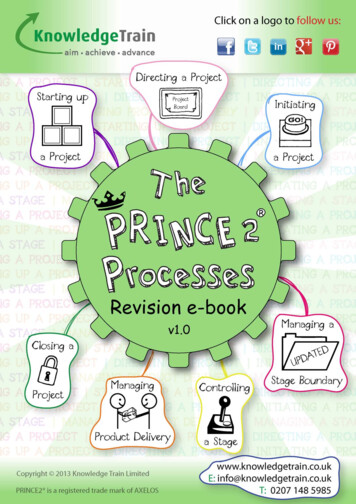

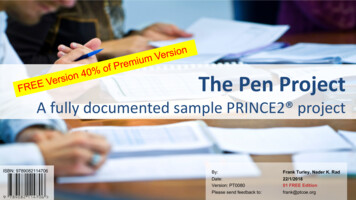
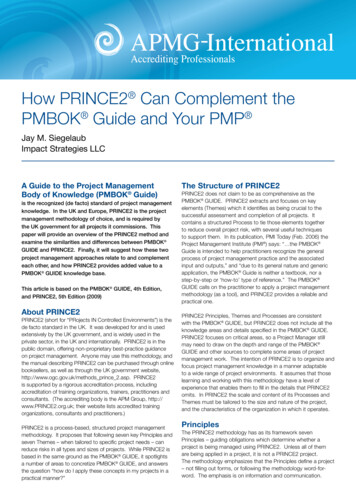

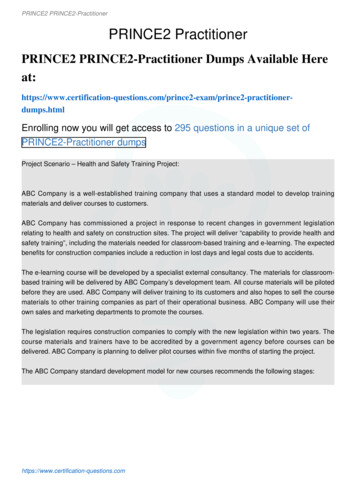

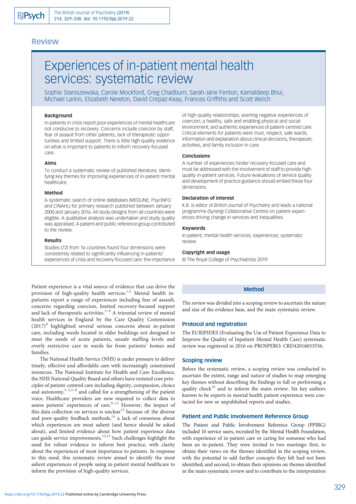
![Managing successful projects with PRINCE2 [PDF] 6th ed.,](/img/18/1-principles.jpg)